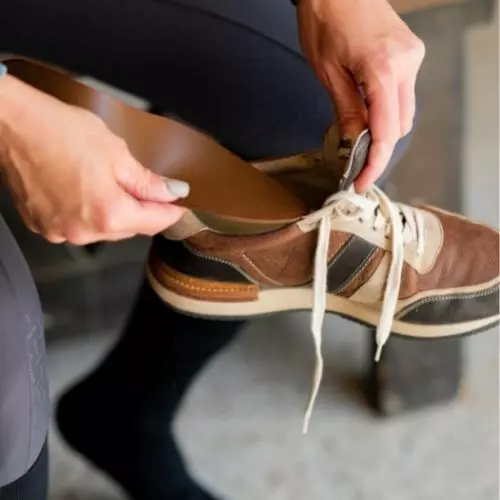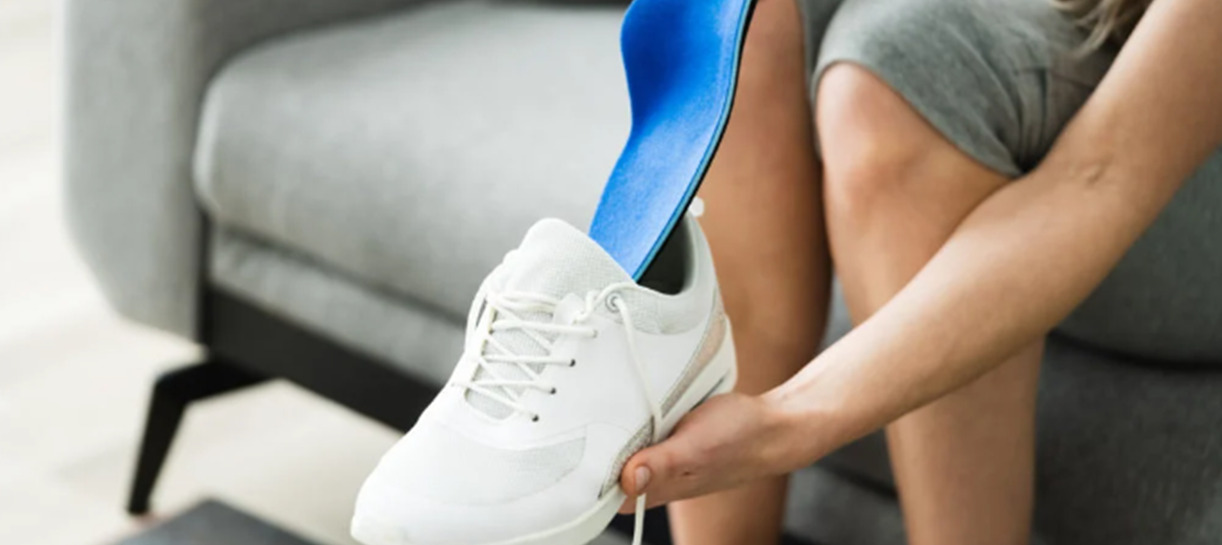Correct insole placement in shoes or boots is important for optimal comfort and foot health. This guide explains the process, from choosing the suitable insole to its proper insertion and care.
Whether you need insoles for medical reasons, comfort, or improved shoe fit, this resource provides the necessary information for successful insole use.
Improve your footwear comfort and foot health with our step-by-step guide on how to accurately insert insoles in shoes and ensure you wear orthotics correctly.
Points Of Note
- Proper positioning of removable insoles and custom orthotics can significantly enhance foot comfort and health.
- Understanding the various types of insoles, prepping shoes for insole placement, following the insertion guide accurately, and ensuring comfort and fit are key steps in this process.
- Regular maintenance of insoles can extend their lifespan, providing ongoing foot support.
- Adherence to these guidelines can help maximize the advantages of using insoles in shoes.
Below is a simple instructional video on how to simply replace insoles.
Understanding Different Types of Insoles
The variety of insoles available for purchase serves different foot conditions and shoe types, each having a unique design and function. Custom insoles, specifically designed according to individual needs such as arch support, and standard shoe insoles for overall comfort and support are among these.
The process of integrating insoles into shoes includes selecting the right type, confirming the correct fit, and seamlessly placing the new insole.
Comprehending these diverse types of insoles is key for optimal foot health and extra support.
Preparing Shoes for Insole Placement
Regular cleaning and drying of your shoes is an important initial step to set them ready for insole placement. Remove existing insoles from the shoe footbed to create space for the new ones. This action will ensure a perfect fit and avoid any discomfort which could occur due to overcrowding.
Make sure your shoes are completely dry before you place the new insoles, this is done to avoid any damage that could be caused by moisture.
Simple Steps For Insole Insertion
To attain the best comfort and support from your insoles, adhering to a detailed guide for accurate placement into your shoes is necessary. Begin by taking out any pre-existing insoles from your shoes.
| Steps | Description |
|---|---|
| 1 | Take out existing insoles |
| 2 | Place new insoles accurately |
| 3 | Confirm a tight fit |
| 4 | Check for comfort and support |
Tips for Proper Insole Placement
Proper positioning of your shoe insoles within your shoes is key for ensuring comfort and support. To obtain the right placement, line up the insole with the natural arch of your foot, making sure to avoid any folding or bunching. The insole should span the full length of your shoe.
Make it a habit to regularly verify that they’re comfortable and supportive, making any necessary adjustments. Adhering to these guidelines will help you get the most out of your shoes by enhancing your insole experience.

Testing Insole Fit and Comfort
Once your insoles are in the right place, the next important step is to carry out a set of tests to make sure the fit and comfort are ideal.
- Put your foot in your shoe and notice how the insole molds to your foot.
- Move around to evaluate the support and feel.
- See if your foot feels tight; if it does, adjust the insole.
- Spend a few hours wearing your new pair for an exhaustive evaluation of insole fit and comfort.
Popular Questions
Below are some common questions we get asked.
What Materials Are Commonly Used in the Manufacturing of Insoles?
Materials such as foam, gel, plastic or carbon fiber are often used in the manufacturing of insoles. Foam provides cushioning, while gel aids in shock absorption. Plastic or carbon fiber is used for structural support. Some insoles might also incorporate cork or leather to enhance their durability.
Can I Wear Insoles if I Have Specific Foot Conditions Like Diabetes or Arthritis?
Sure, those with specific foot conditions such as diabetes, flat feet, or arthritis can indeed use insoles. Insoles can aid in alleviating discomfort, lessening stress on sensitive areas, and enhancing the functionality of the foot. It’s recommended to seek advice from a health professional for individualized guidance.
How Often Should I Replace My Insoles for Optimal Foot Health?
The frequency of replacing insoles hinges on how often they’re used and the quality of the insole. Generally, it’s suggested to change insoles between every 6 to 12 months. However, if you’re using them heavily or experiencing discomfort, you might need to replace them more often to ensure your feet remain healthy and comfortable.
Are There Any Specific Cleaning or Maintenance Instructions for Insoles?
It’s recommended to check insoles periodically for signs of wear and clean them following the manufacturer’s instructions. Many can be lightly washed by hand using a gentle soap and allowed to dry naturally. It’s recommended not to expose them to direct heat. Regular upkeep can help them last longer.
Final Notes
Correct placement of insoles greatly improves foot comfort and health.
Knowing about the different types of insoles, getting shoes ready for insole placement, accurately adhering to the insertion guide, and checking for comfort and fit are important steps in this process.
Consistent care and upkeep of insoles can prolong their lifespan, ensuring continued foot support.
By adhering to these guidelines, one can maximize the benefits of using insoles in shoes.

